Lenovo ThinkStation P620 Performance
We wanted to show performance in the context of high-end Xeon W, dual Xeon, and even AMD EPYC and standard Threadripper systems as well. For this, we are using Ubuntu Linux. We previously published these numbers as part of our Threadripper 3995WX review. Since that review was done in the ThinkStation P620, these are the same numbers and we are just going to consolidate what we had there into this workstation review.
We are going to show off a few results, and highlight a number of interesting data points in this article.
Python Linux 4.4.2 Kernel Compile Benchmark
This is one of the most requested benchmarks for STH over the past few years. The task was simple, we have a standard configuration file, the Linux 4.4.2 kernel from kernel.org, and make the standard auto-generated configuration utilizing every thread in the system. We are expressing results in terms of compiles per hour to make the results easier to read:
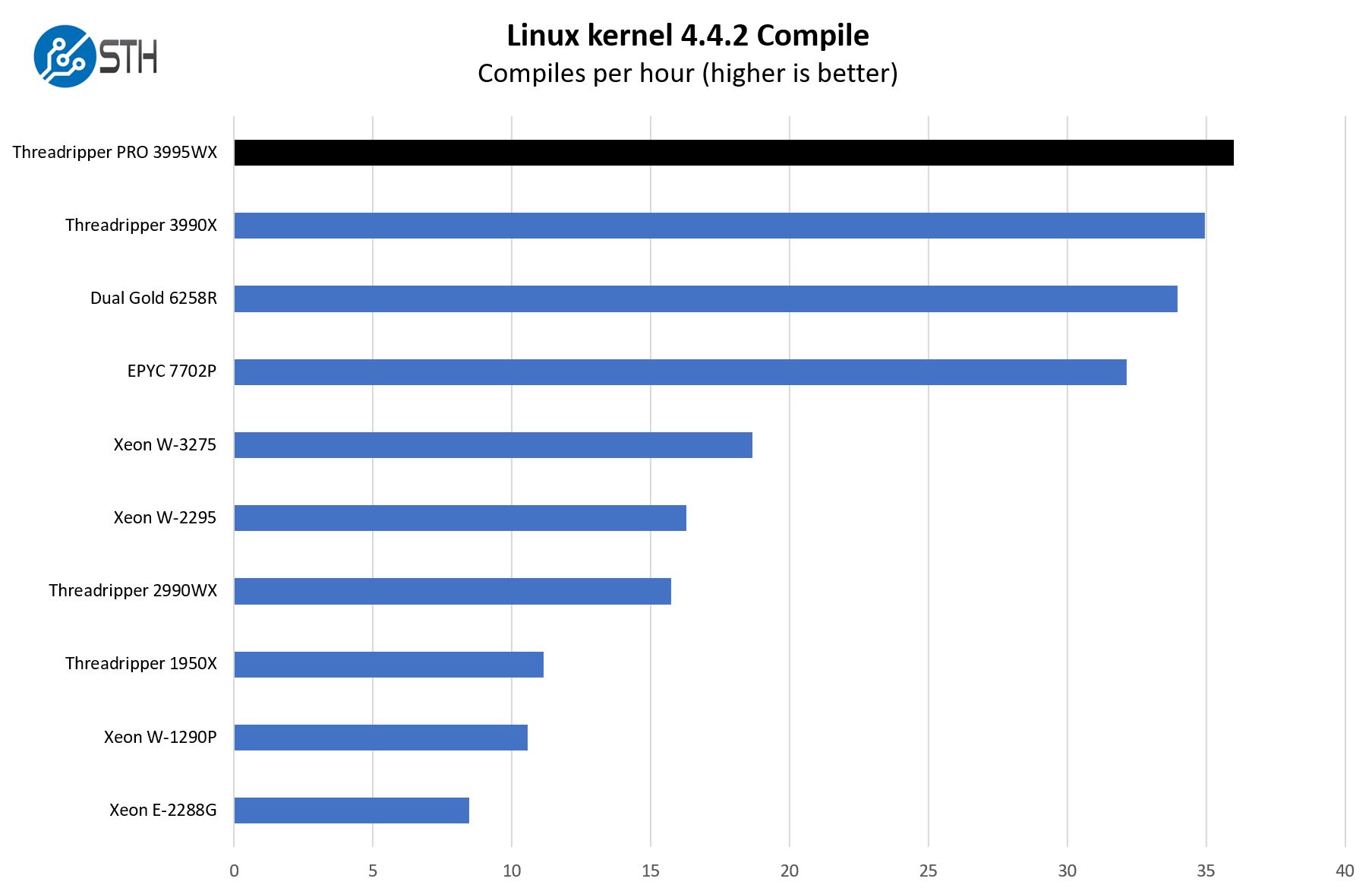
Plenty of cores and TDP means we see a solid figure here. We also get a nice benefit from the additional memory bandwidth.
c-ray 1.1 Performance
We have been using c-ray for our performance testing for years now. It is a ray tracing benchmark that is extremely popular to show differences in processors under multi-threaded workloads. We are going to use our 8K results which work well at this end of the performance spectrum.
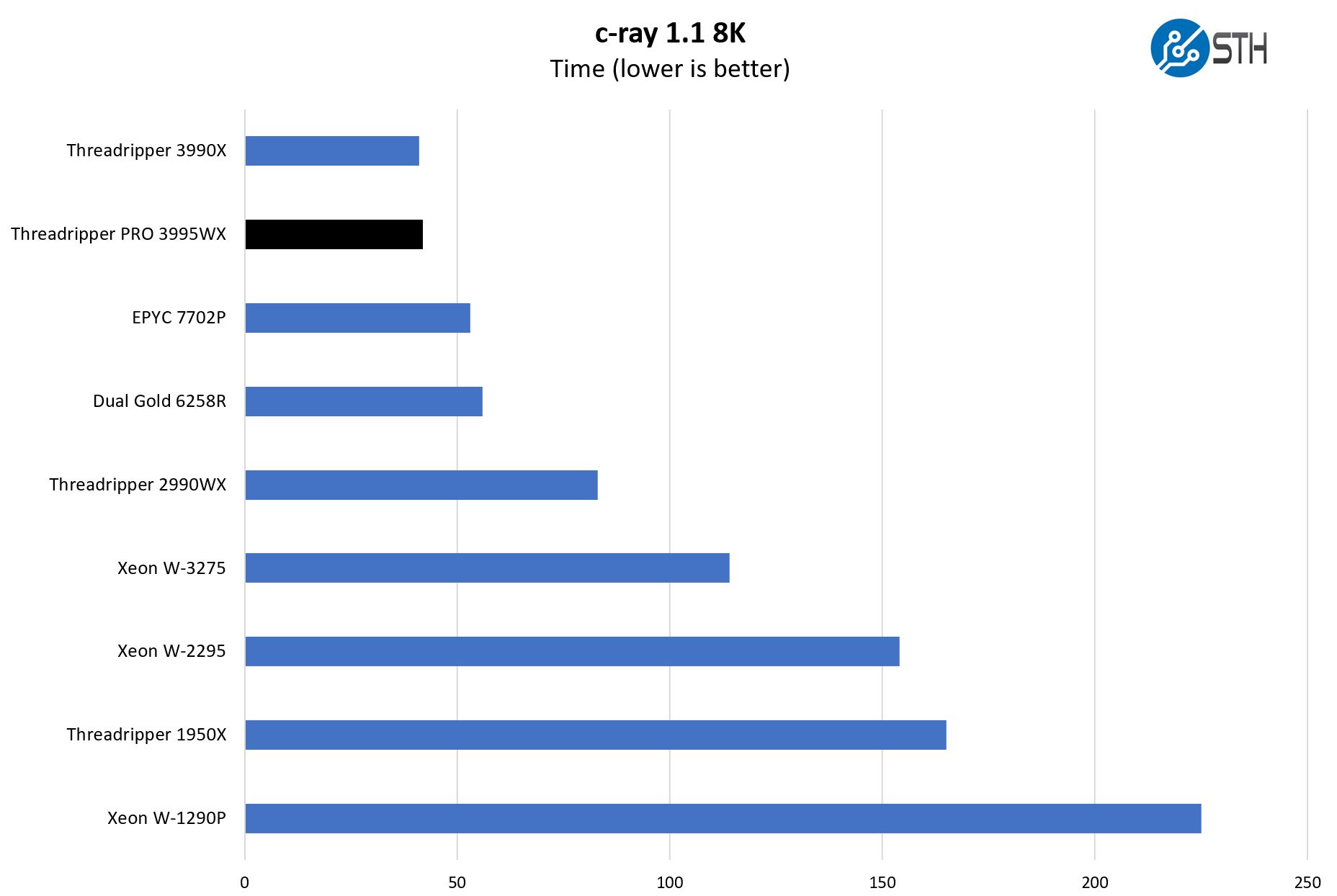
This test relies much less on memory bandwidth, and interestingly we see the Threadripper 3990X show a small gain. Logically, this makes sense given we have very similar compute complexes.
7-zip Compression Performance
7-zip is a widely used compression/ decompression program that works cross-platform. We started using the program during our early days with Windows testing. It is now part of Linux-Bench.
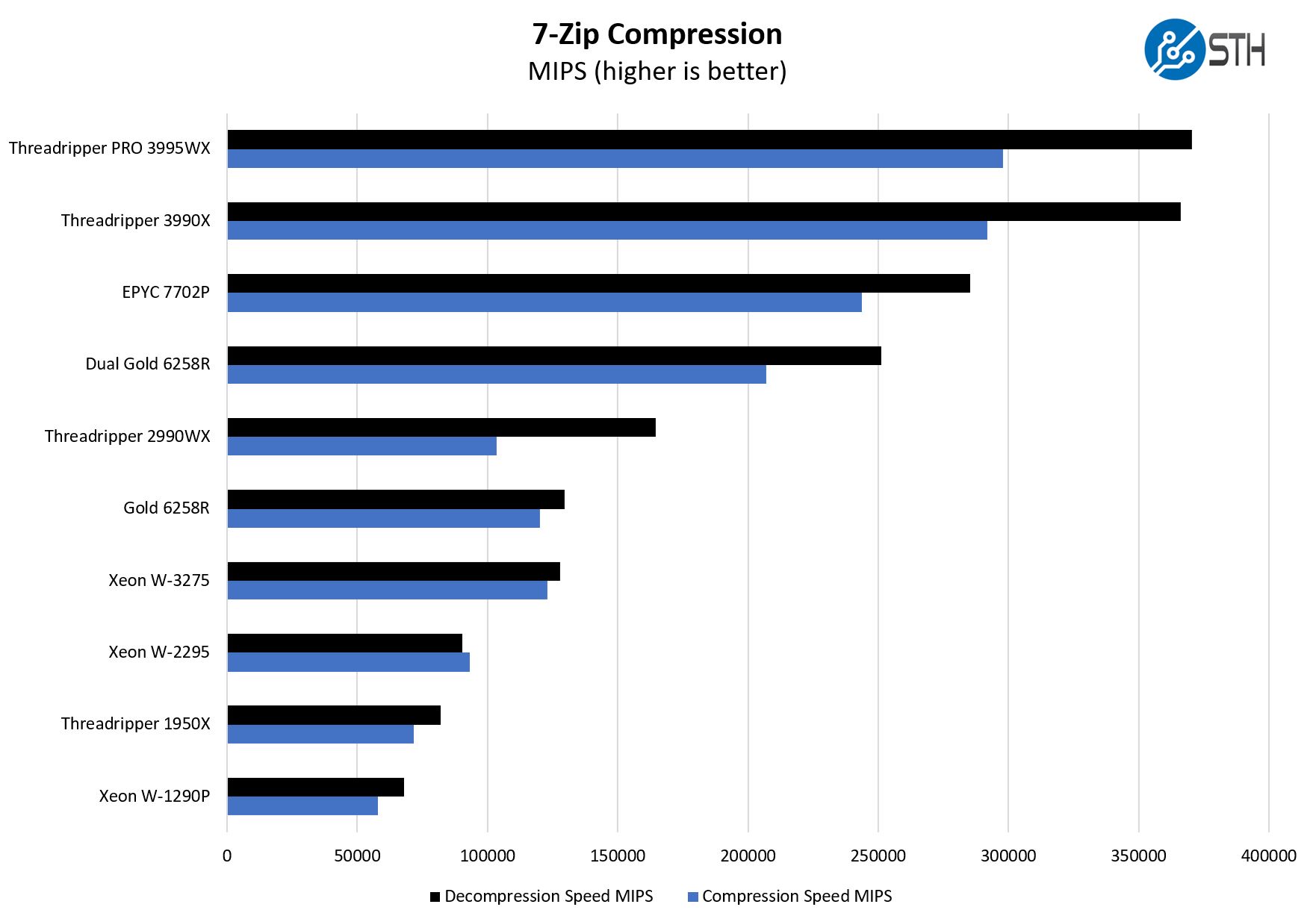
While the AMD Ryzen Threadripper 2990WX also had the “WX” moniker, we see here a result that shows a bit of why it was not necessarily a clear winner in the workstation market. Perhaps it was an attempt to get OEMs to bite on AMD platforms for their professional workstations that did not work at the time.
NAMD Performance
NAMD is a molecular modeling benchmark developed by the Theoretical and Computational Biophysics Group in the Beckman Institute for Advanced Science and Technology at the University of Illinois at Urbana-Champaign. More information on the benchmark can be found here. Here are the comparison results for the legacy data set:
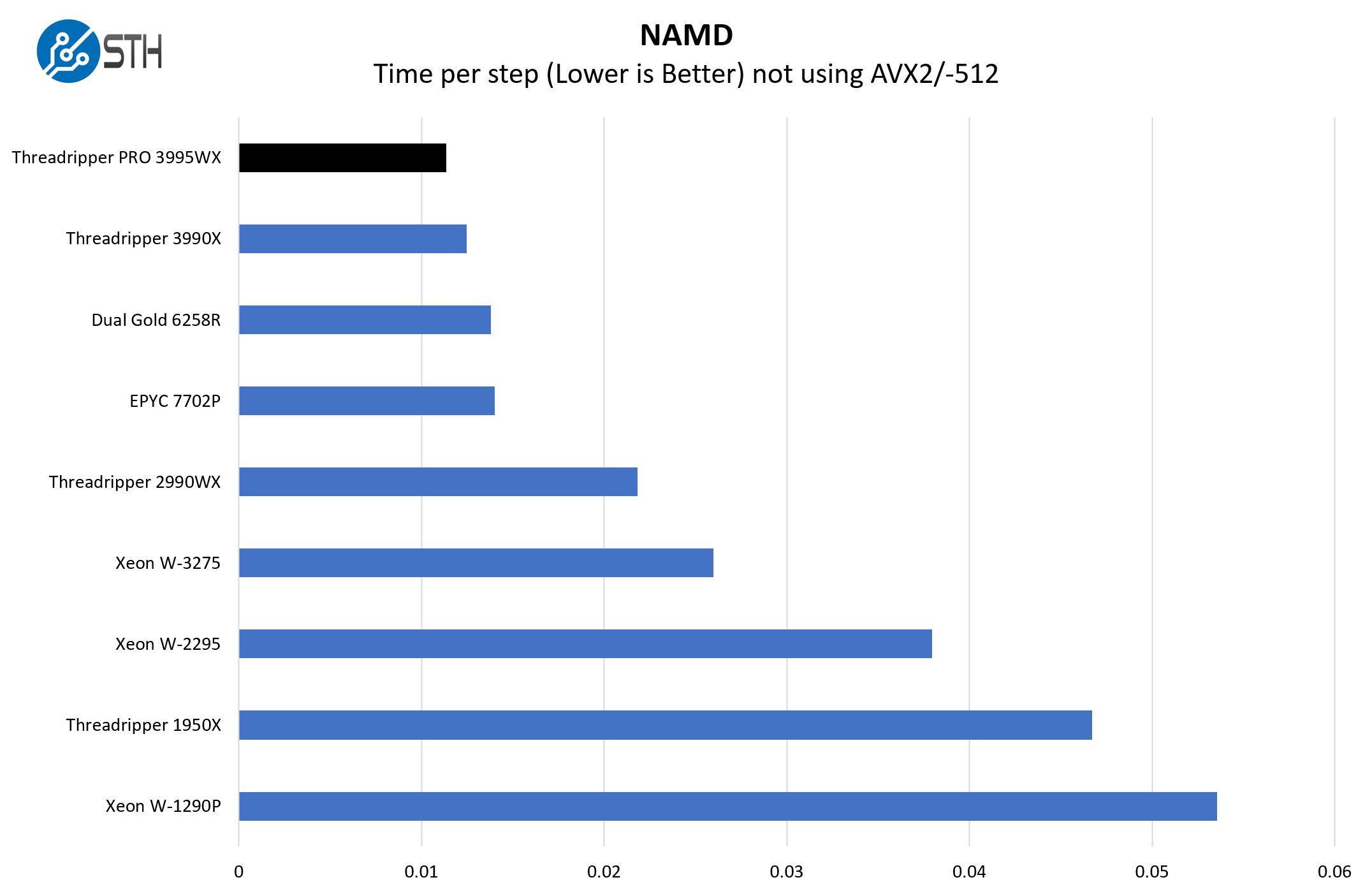
Here we got absolutely great results. There is not much more we can say about this.
OpenSSL Performance
OpenSSL is widely used to secure communications between servers. This is an important protocol in many server stacks. We first look at our sign tests:
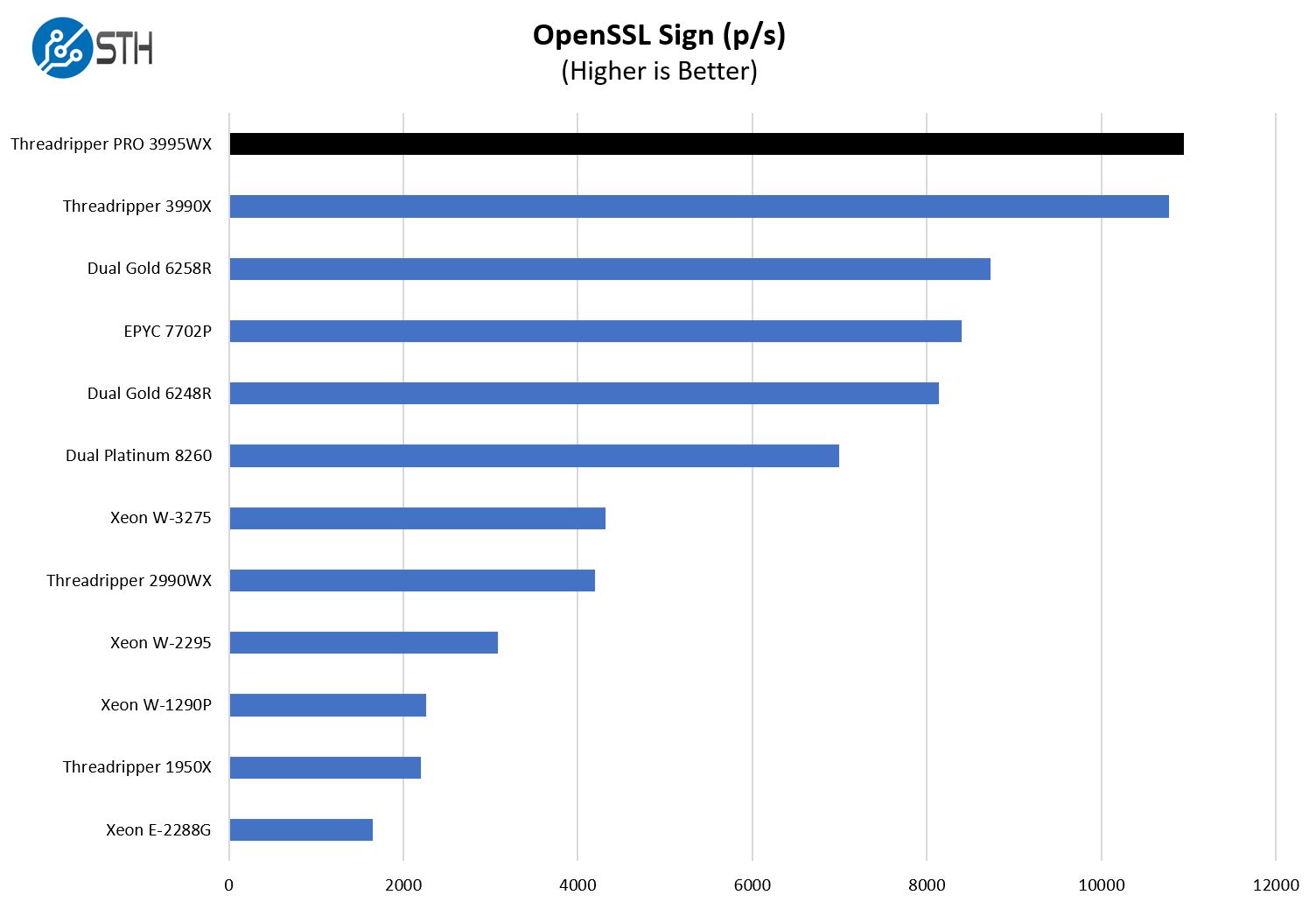
Here are the verify results:
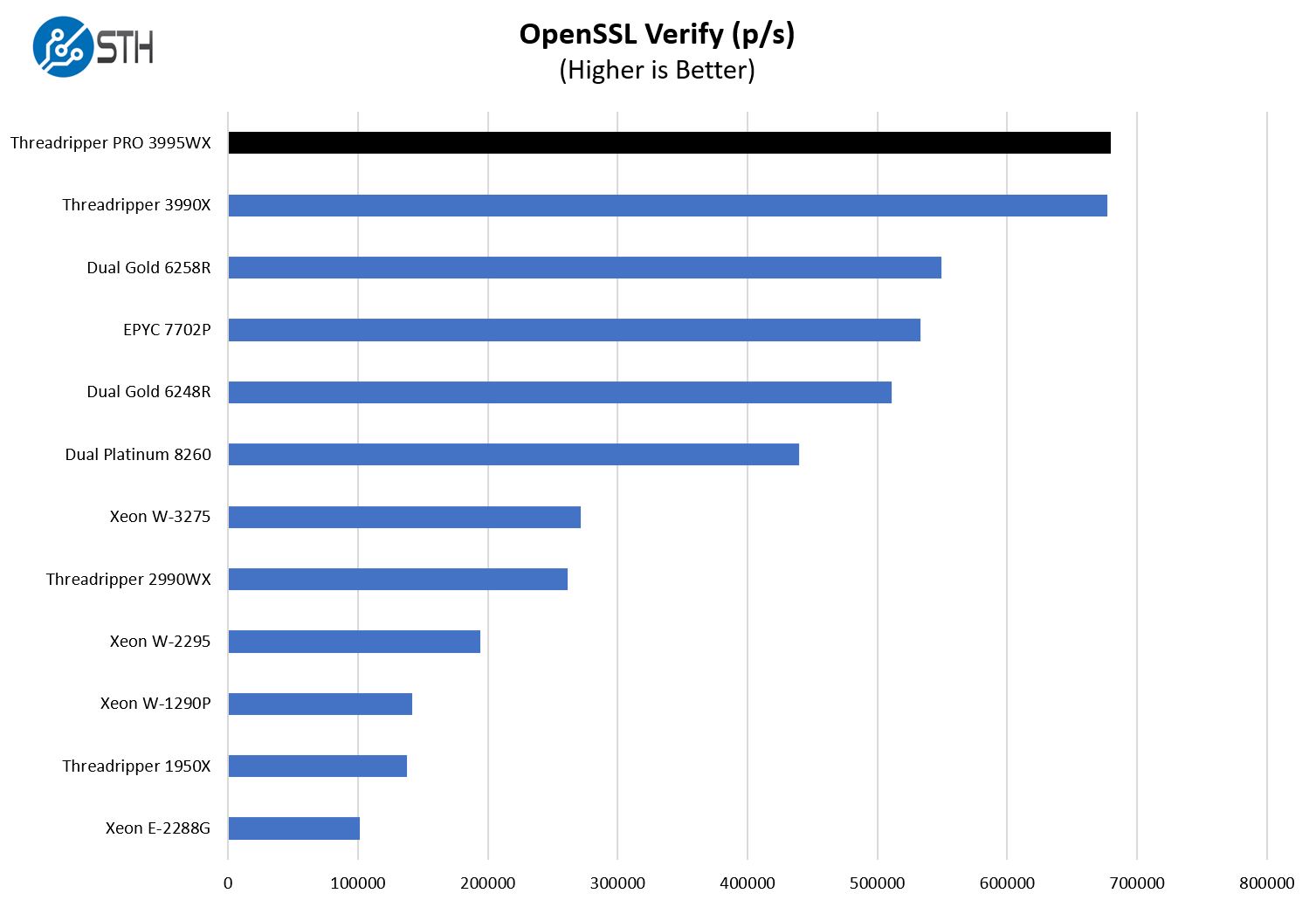
One may notice we have been adding a number of different dual Intel Xeon offerings in these charts. We also have the single-socket Intel Xeon W-3275, Xeon W-2295, and Xeon W-1290P just to show those levels of single-socket performance. To be clear, in this market many will have per-core software licensing and not necessarily want a 64-core CPU. Still, for the segment that is scaling to higher-core counts, this is impressive.
UnixBench Dhrystone 2 and Whetstone Benchmarks
Some of the longest-running tests at STH are the venerable UnixBench 5.1.3 Dhrystone 2 and Whetstone results. They are certainly aging, however, we constantly get requests for them, and many angry notes when we leave them out. UnixBench is widely used so we are including it in this data set. Here are the Dhrystone 2 results:
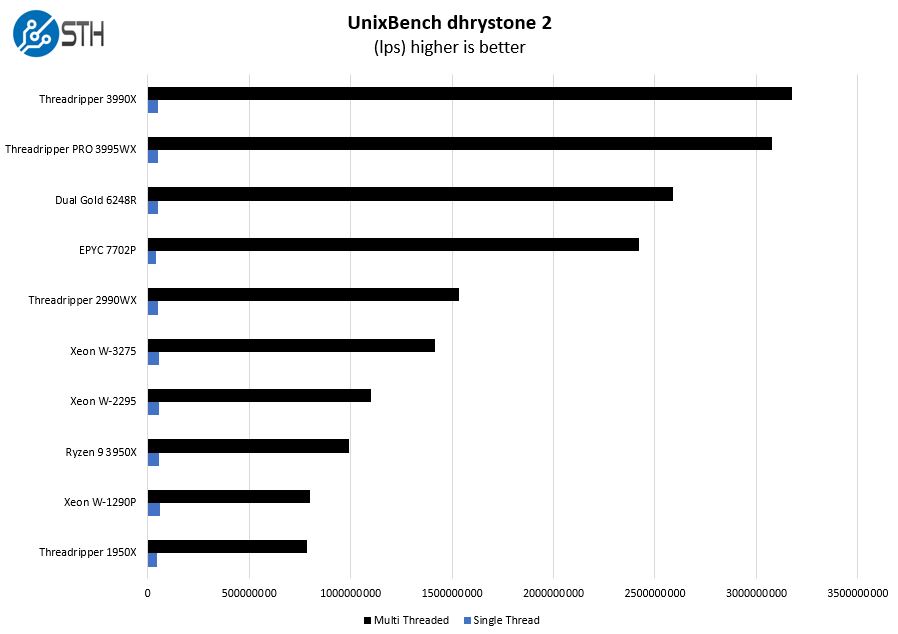
Here are the whetstone results:
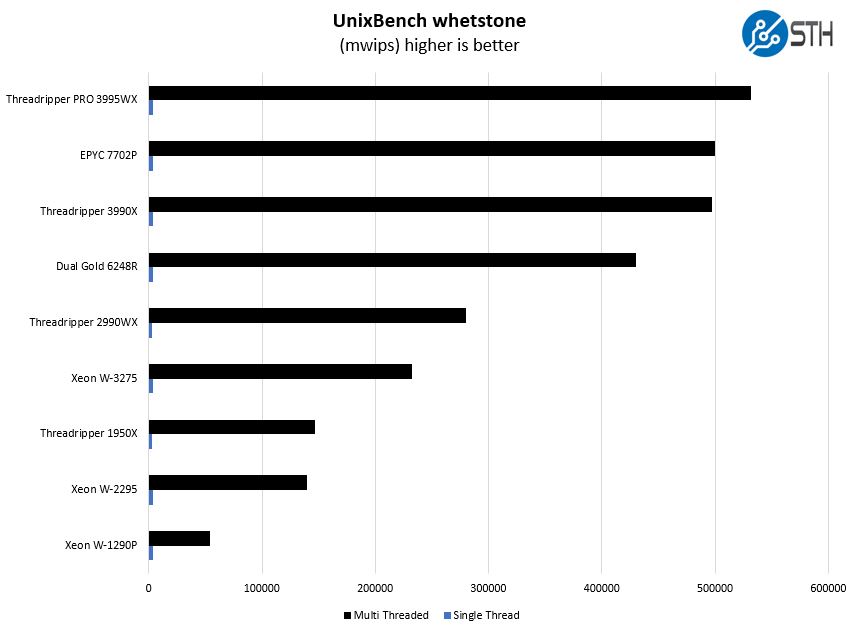
We are trying to phase-out these results, but since this is effectively a 2019-2020 era chip, we wanted to still include them here for comparison purposes.
Chess Benchmarking
Chess is an interesting use case since it has almost unlimited complexity. Over the years, we have received a number of requests to bring back chess benchmarking. We have been profiling systems and are ready to start sharing results:
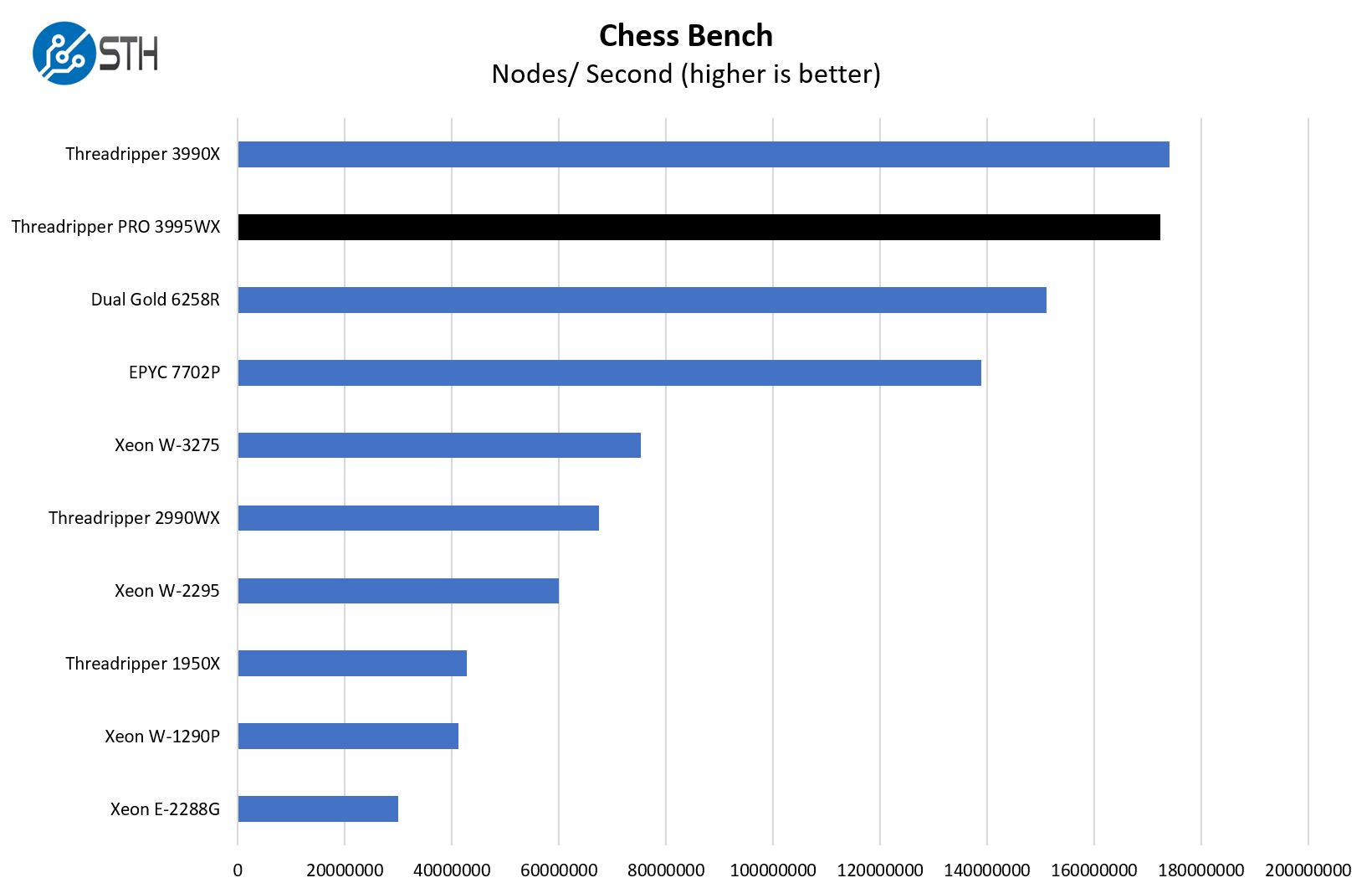
Something that we will note is that in the EPYC 7003 “Milan” generation we get a large speedup here from the bmi2 performance. Since these are launching around the same time as Milan is at hyper-scalers, we double-checked results here to see that it was more in-line with the “Rome” generation.
STH STFB KVM Virtualization Testing
One of the other workloads we wanted to share is from one of our DemoEval customers. We have permission to publish the results, but the application itself being tested is closed source. This is a KVM virtualization-based workload where our client is testing how many VMs it can have online at a given time while completing work under the target SLA. Each VM is a self-contained worker.
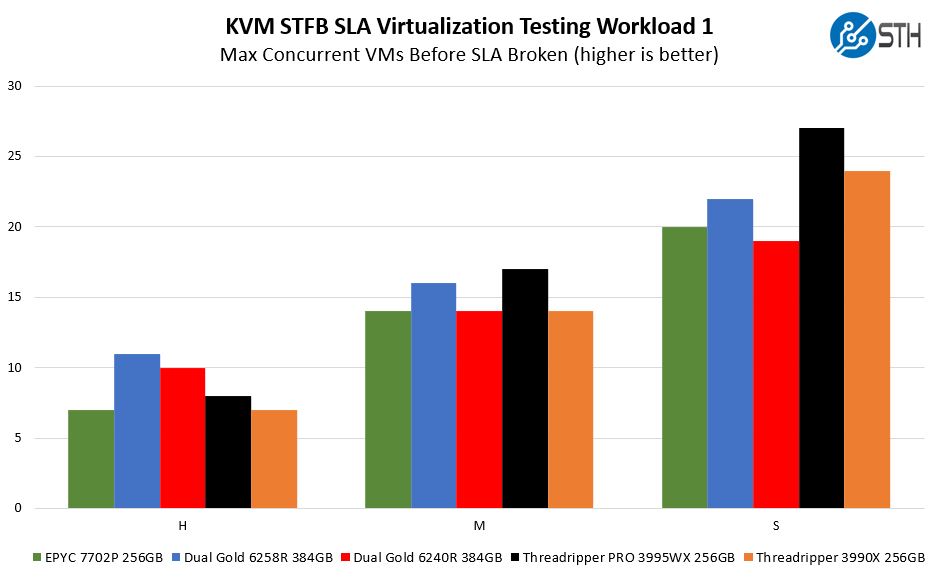
Here there are a few key points. First, the higher memory VMs are being impacted more by memory capacity than CPU performance here. This is a workload geared more towards servers where we expect 256GB to be a minimum configuration when we were profiling it. Still, as we move away from the most memory capacity bound side to the more CPU/ memory bandwidth bound side we get a nice speed-up versus the Threadripper 3990X. There is a lot that goes into the performance that includes memory capacity, bandwidth, and CPU performance and it is nice to see all of those showing impact here.
Next, we are going to start our testing with computing-related benchmarks.




How many dB 1m from chassis when under load and idle?
1. Stop using “WEPYC”, it’s misleading and sounds atrocious
2. The DVD bay does not rotate to make it tower like? Dell/Supermicro have been doing that for ages, shame Lenovo could not have done the same.
3. Stop using “WEPYC”
Another good article, and nothing wring with the WEPYC nickname.
But Wepyc is just such an awesome name for what this is. AMD should pay Patrick to adopt it, in fact.
The pre-discount pricing of U$6K for 16c 32MB was eyewatering, discount pricing is still a bit stiff: https://www.lenovo.com/us/en/think-workstations/thinkstation-p-series-towers/ThinkStation-P620/p/33TS3TPP620 – the “W” is for Whoa!
It just occurred to me that the 12/16C models will suffer from the memory bandwidth problem, no? If they are indeed implemented as two CCD as the Wikipedia page suggests, then the aggregate CCD to/from IO die connectivity would be half of the 8 channel memory bandwidth. That sucks. I would have expected 12/16C models to be implemented with 4 CCD even if that means only singe CCX is used on a CCD. Bummer!
I have a P620 with the 3945WX and a W5700 on the way. I only have enough RDIMMs to do a four channel test, but I’m willing to run any benchmarks anyone here would like.
If anyone has four more 16GB RDIMMs to toss my way for benchmark purposes I could check the bandwidth question out as well.
hi Rob,
it’s 15 years since I last wrote a PO myself and to the old public Dell, however we enjoyed better than any online quotes and specials and far better than that on GPUs.
we were able to buy as a small business customer after engineering to be a non consolidated subsidiary of our parent.
many corporate organisations incorporate functions and divisions separately but breaking them out if they’re going to be consolidated anyway is not always easy to negotiate. We did and certainly could, because of a excellent structured finance department who kept us a startup in every positive and naturally inherently eminent way we were.
I mention this because if you need a high degree of acceleration and options, unless the parts aren’t available via the small business channel (PERCs were not on workstations at least at that time*) the possibility of developing a positive relationship with your account manager who may benefit from developing their familiarity with your niche market needs, feeds from this naturally and did with us on numerous occasions.
*I really should add my caveat emtor to bending sales channels that I learned when the Adaptek card lost its array tables in a way that no LSI would have done. I was asking to serve my head on a plate to the data gods when I said “go ahead” despite a consensus suspicion that that “PERC” (labelled, silk screened and BIOS declared) was inevitably going to lose the array tables, because not only didn’t anyone we could find believe that the PERC brand would be risked and the manual pages were identical to earlier parts and yet despite being never in doubt about our relationship with Dell our Dell counterparts themselves were as dumbfounded as the extent of cliché and caricatures can exemplify. I think we’ve still this very machine in storage – we mothballed it immediately afterwards in case anyone else needed to corroborate a identical failure and needed a case study to invoke insurance terms or even if Dell needed to go back to the OEM. I have never ever heard of a Adaptek in a Dell otherwise and this was in my view the time when Dell was beginning to scream out for the help that privatisation eventually delivered resoundingly.
if you are independent or able to get independent tax codes for your subsidiary unit and are looking at large – for – normal – small – business purchasing, and you have the time and manpower and the further time after purchasing, to level up your vendor team to understand your needs, and this is fine with vendor corporate, I have to say that we enjoyed superb experiences and economic terms as close to the bone as we could dare to ask. I highly recommend this strategy for a initial training project, for example.
I still omitted my points :
merely being more familiar with the technology would have almost certainly prevented that data loss – the card was fully supported but I am Perfectly Peachy Embarrassed just writing about this 15 years later because obviously I called it stupidly. Nonetheless, if our support technician and his line management worked datacenter accounts and not small business, I think numerous safeguard actions would have at least intervened to stop my stupidity. In my defense the data loss was meta data loss only, but expensive because it was the only copy of my nearly finished hand indexing of my 20 years of research files and papers and correspondence. I hadn’t backed up the most recent key to the tape archive job. Actually this whole mess was caused by my impatience with finishing work that wasn’t necessary at all and I was lucky to lose no records.
yep I am still beating myself up over that
the positive reason for this writing however I hope makes those previous pixels more acceptable, because I could have lead with more recent successes with obtaining dramatic discounts on integrated vendor hardware and maybe I should have done so.
in 2005 our Quadros MSRP $5,000 turned into line items at numbers below $2,000
we’ve been out of GPU requirements for 3 generations
however what I just said has been a reliable ballpark for the whole of this century for my company through multiple different types of incorporation and geographical location.
bluntly if you can get better discounts on GPU for today’s silicon, and I included as much caveats as I could since I can’t say anything except for the obvious which is you’d be doing extremely well to obtain comparable discounts as we have in the past, however despite my uncertainty in many respects, I am entirely sure that significant margin exists to reduce your quotes for workstations like this WEPYC today.
if you can invest in your vendor channel relationship sufficiently to the level where you can believe that your reps and team are going to build their business and break targets thanks to your involvement with them, I am entirely sure that you can secure the most meaningful economic benefits for your business that are possible for your vendor to afford you.
before you think about pricing however, do you have the capacity to reverse engineer your vendor’s team’s economics sufficiently accurately so that you will not be hitting any of their pain points during your negotiations?
are you sure that you can use independent economic intelligence to your advantage in ways that are absolutely incapable of creating in your vendors team any suspicion of leaking to you in any way whatsoever?
(buying industry market intelligence is a good option here and may potentially be helpful for your vendor team to learn from, although I don’t need to advise against didactic demeaning it’s really worth working out how this comes across beforehand and I’ve cold called at board and CxO for 35 years and I don’t find this at all easy)
I’ve blackened too many pixels here but I’ll leave this with just saying that the price of a specialist PR to write and photograph / talking head shoot the sale as a case study could repay you many times over. my company used to do all that as well if I asked I’ll respond best I can / appropriate / offline
” WEPYC ”
should have been coined in conversation with some interesting participants in the workstation EPYC ecosystem, to give it the introduction necessary.
This is a seemingly trifling but very definitely serious loss to the pandemic. Any other year and the PLATRONYM WEPYC would be serving efficient duty in the war on the market selling advanced solutions depending on the EPYC ecosystem. Chatting with the vendors most impacted – anyone needing PCIEV4 will do, but someone who has a good enough horizontal angle to want to downplay the platform and present their solutions as turnkey would be behind using WEPYC in enough ways it would have take-up plenty as of Christmas in private already.
I reacted negatively at first but quickly realised that my reaction was caused by the lack of vital context and transforming meaning.
the reaction I’m reading signals to me only that we’re hurting in unseen ways without closer industry community contacts happening
oh, I consistently was securing the First In Country Supply for the parts that we wanted.
this and our developed strategy has delivered us components frequently before very major accounts got theirs
supply has clearly stratified beyond recognition of my personally responsible days, we have delayed buying metal ourselves for over 2 years and will probably take delivery 3 years after our original planning dates, because we wanted to learn intimately what’s going on around the industry now. We’ve used cloud machines to be as early as possible as general public to learn as much as possible without any favors. Because of the stratification and the pressure of demand for next generation hardware, we’ve tried to pass on the present cycle to use this cycle to develop the knowledge and relationships – extending outward from who we work with already wherever possible – the risks we considered necessary to avoid to the point that we’re effectively contracted to key customers instead of selling to the market for now.
apart from boasting about the results I’ve helped get negotiating with vendors, I’m wanting to say that if you are likewise talking with new people and new channels, from where I see lots of people are almost sitting this one out to commit better in H222. no need to even necessarily start hinting about bigger business to come next time because I think about everybody is doing similar
hi to William and Patrick and STH team!
any chance of getting two MSI 3090s into this wepyc to test with the rest of the slots as loaded as possible?
I’ve written altogether too much but my business encompasses video production and 8K RED raw files scrub nicely only with RTX silicon which Apple doesn’t sell leaving clackintoshes (cloud + hack +) run on esxi the most sensible interim way
many people would love to serve a RTX to a colleague while checking out the state of play on Linux and Windows, Linux extensively used for paint and color work witht the high end applications coming within reach of the many due to hardware improvements so vastly lower license pricing recently (tens of kilobucks per seat to low single digit thousands now for Katana and Mark and similar to zero for NLEs…) and with bundles of legacy cards to bring over, this is a highly relevant configuration to think about. Consider everybody who could afford got a $20k RED rocket FPGA raw decode accelerator card only 3 years ago… the Brits are big in this game too and getting much less support for everything. Meanwhile the indy industry is in trouble big time and can’t afford to pay twice for workstations. this is a market in desperate need of your attention and insights.
Anyone knows the “normal” weight of this workstation? Lenovo’s documentation only lists maximal weight, which might include multiple GPUs and HDDs. I’d like to get one, however I need to put it in a holder hanging from a desk, which has strict weight limits. The maximal weight listed on Lenovo’s site is way above that maximum.
Got an answer on Lenovo forums: 29lbs / 13.2kg for a basic version. Going to get one soon.
Great machine but our newly purchased ThinkStation P620 suffers from a sudden power loss type shutdown, usually when not under any load. This happens around every 2 weeks.